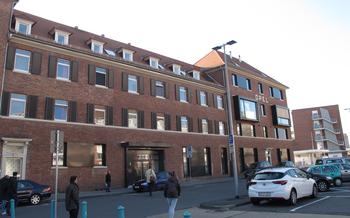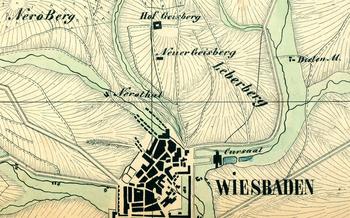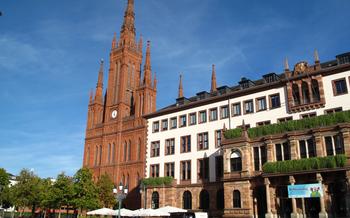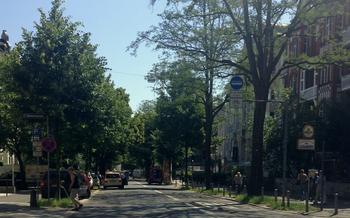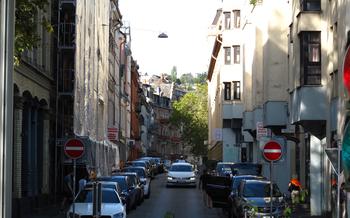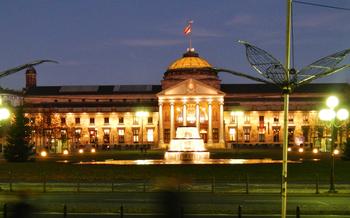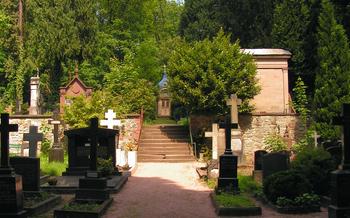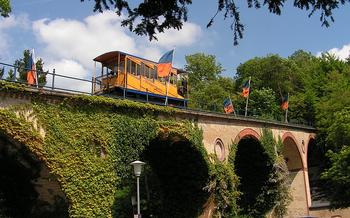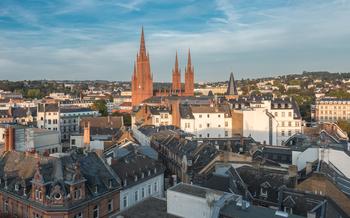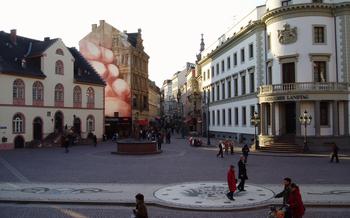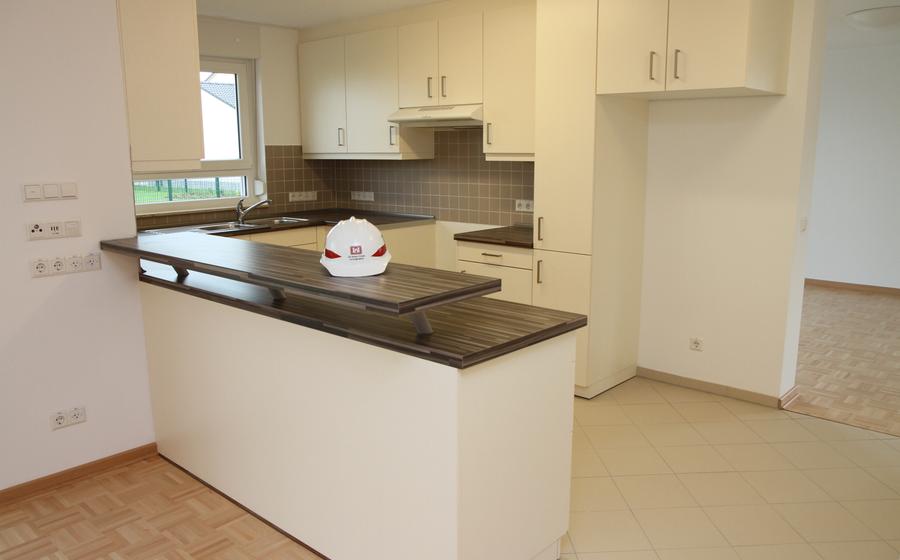
Thermal Area of Wiesbaden
- Thermal Springs: A Historical Legacy
- Kurpark: A Green Oasis
- Kurhaus: Elegance and Entertainment
- Römertor: A Gateway to History
- Marktplatz: The Heart of the City
- Wiesbaden Casino: Lady Luck Awaits
- Nerobergbahn: A Scenic Ascent
- Museum Wiesbaden: Art and History
- Biebrich Palace: A Royal Residence
- Wine Tasting in the Rheingau
- Day Trip to Mainz
- Insider Tip: Exploring the Neroberg Woods
Thermal Springs: A Historical Legacy
Wiesbaden's thermal springs have been renowned for their healing properties since Roman times. The Romans built elaborate bathhouses and temples around the springs, believing in their therapeutic powers. In the 19th century, Wiesbaden became a popular spa town, attracting visitors from all over Europe who sought relief from ailments such as rheumatism, gout, and skin diseases. The city's reputation as a spa destination continues to this day, and its thermal springs remain a major draw for tourists.
I personally experienced the healing power of Wiesbaden's thermal springs during a visit to the city. I had been suffering from chronic back pain for several years, and nothing seemed to help. But after a few days of soaking in the warm, mineral-rich waters, my pain began to subside. By the end of my stay, I was virtually pain-free. I was amazed by the effectiveness of the springs, and I left Wiesbaden feeling refreshed and rejuvenated.
Kurpark: A Green Oasis
Amidst the bustling city center, the Kurpark, or Spa Park, offers a tranquil retreat for both locals and visitors. This sprawling green sanctuary, dating back to the 19th century, is a testament to Wiesbaden's rich spa culture. As you step into the park, the soothing sound of trickling water and the sweet fragrance of flowers fill the air.
Strolling along the shaded paths, you'll encounter numerous attractions that add to the park's charm. The colonnade, with its elegant columns and arches, provides shelter from the sun and rain while offering picturesque views of the park's lush greenery. The fountains, with their graceful spouts of water, create a mesmerizing spectacle that delights visitors of all ages.
To fully immerse yourself in the park's beauty, take a break on one of the many benches and simply soak in the tranquil atmosphere. Observe the ducks gliding gracefully on the pond, listen to the cheerful chirping of birds, and let your worries melt away as you bask in the serene ambiance of the Kurpark.
For those seeking a more active experience, the park offers a variety of options. Jogging paths wind through the park, inviting you to get your heart pumping while enjoying the fresh air. There's also a playground where children can run, climb, and swing to their heart's content.
As you explore the park, keep an eye out for hidden gems. Tucked away among the trees, you might find a secluded rose garden, a charming statue, or a historic monument that tells a story of Wiesbaden's past. These hidden treasures add an element of surprise and delight to your visit, making the Kurpark a truly enchanting place to explore.
Kurhaus: Elegance and Entertainment
The Kurhaus is an architectural masterpiece and a symbol of Wiesbaden's grandeur. Its neoclassical facade, adorned with intricate carvings and sculptures, reflects the city's rich history and cultural heritage. Originally built in the 19th century as a spa and entertainment center, the Kurhaus has hosted countless events, from lavish balls to prestigious concerts.
Inside, the Kurhaus boasts a variety of elegant halls and rooms, each with its unique charm. The grand ballroom, with its high ceilings, crystal chandeliers, and ornate mirrors, is a sight to behold. It has witnessed countless social gatherings, royal banquets, and glittering parties throughout the years.
The Kurhaus is not just a historical landmark; it's also a vibrant cultural hub. It hosts a wide range of events, including classical music concerts, theater performances, art exhibitions, and international conferences. Attending a classical music concert in the Kurhaus' grand hall is an unforgettable experience. The acoustics are superb, and the atmosphere is electric as the orchestra fills the room with enchanting melodies.
Insider tip: For a truly special experience, book a table at the Kurhaus' renowned restaurant. Indulge in a gourmet meal while enjoying live music and stunning views of the surrounding park.
Römertor: A Gateway to History
In the heart of Wiesbaden's old town, the Römertor stands as a testament to the city's rich Roman history. This imposing gate, constructed in the 2nd century AD, once served as the main entrance to the Roman city of Aquae Mattiacorum. Its sturdy construction and impressive size hint at the grandeur of the Roman Empire that once ruled these lands.
The Römertor is more than just a historical relic; it's a symbol of Wiesbaden's enduring spirit. Despite the passage of time and the many changes the city has undergone, the Römertor has remained a constant presence, bridging the gap between Wiesbaden's ancient past and its modern identity.
Take a moment to admire the intricate details of the gate, including the carved faces that adorn the archway. Imagine the bustling streets of Aquae Mattiacorum, filled with Roman soldiers, merchants, and visitors seeking the healing waters of Wiesbaden's thermal springs.
One morning, as the sun cast a golden glow over the city, I stumbled upon the Römertor during a leisurely stroll. Its weathered stones and imposing presence filled me with a sense of awe. I couldn't help but wonder about the countless individuals who had passed through this gateway throughout the centuries, each with their own stories to tell.
Whether you're a history buff or simply someone who appreciates architectural marvels, the Römertor is a must-see attraction in Wiesbaden. Let it transport you back in time, to an era when Wiesbaden was a thriving Roman city, and marvel at the enduring legacy of the Roman Empire.
Marktplatz: The Heart of the City
The Marktplatz, or Market Square, is the vibrant epicenter of Wiesbaden, where history, culture, and community converge. This picturesque square is framed by an array of architectural wonders, including the Gothic-style Rathaus (City Hall), adorned with intricate carvings and a striking clock tower. The square's centerpiece is the Marktkirche (Market Church), a Protestant church with a soaring steeple and a past dating back to the 13th century.
The Marktplatz pulsates with life throughout the day. During the week, it hosts a bustling market where vendors display an array of fresh produce, flowers, and regional specialties. The air fills with the enticing aromas of bratwurst sizzling on grills and the sweet scent of freshly baked pastries. On weekends, the square transforms into a lively gathering place, where locals and visitors alike stroll, sip coffee at outdoor cafés, and soak up the convivial atmosphere.
For a true taste of Wiesbaden's culinary delights, be sure to visit the weekly market, held every Wednesday and Saturday. Here, you can sample an array of regional delicacies, from the famous Handkäs mit Musik (a tangy cheese served with onions and vinegar) to freshly baked pretzels and aromatic Glühwein (mulled wine) during the winter months.
Wiesbaden Casino: Lady Luck Awaits
In the heart of Wiesbaden's vibrant city center, a majestic building stands as a testament to opulence and entertainment—the Wiesbaden Casino. Established in 1810, it is one of Germany's oldest and most renowned casinos, attracting visitors with its architectural beauty and rich historical significance.
The casino's grand facade, reminiscent of a stately palace, invites guests into a world of glamour and excitement. Inside, the elegant gaming rooms feature an array of tables and slot machines, offering a thrilling experience for both seasoned players and newcomers alike.
Beyond the gaming tables, the casino offers a variety of entertainment options, including live music performances, cabaret shows, and fine dining experiences. The elegant restaurant serves delectable cuisine, while the stylish bar offers a wide selection of beverages and cocktails.
To ensure a seamless and enjoyable visit, the casino provides practical information for guests. A dress code is in place, requiring smart casual attire. Admission fees are nominal, and gaming regulations are clearly displayed.
For an unforgettable evening of entertainment and a chance to try your luck, the Wiesbaden Casino is an unmissable destination. Whether you're a seasoned gambler or simply seeking a night of excitement, the casino offers a captivating experience that will leave you enticed and entertained.
Nerobergbahn: A Scenic Ascent
Wiesbaden offers a unique and unforgettable experience with the Nerobergbahn, a funicular railway that takes visitors on a scenic journey up the Neroberg hill. This century-old railway is a true engineering marvel, climbing the steep slopes with ease while providing breathtaking views of the city and the surrounding region. As the train gently ascends, passengers can admire the lush greenery, colorful vineyards, and charming neighborhoods that make up Wiesbaden's picturesque landscape.
The highlight of the ride comes at the top of the Neroberg, where visitors are rewarded with panoramic vistas that stretch for miles. From this vantage point, one can see the entire city of Wiesbaden, the meandering Rhine River, and the distant Taunus Mountains. It's a moment of pure bliss, where the worries of the world melt away, replaced by a sense of awe and tranquility.
Insider tip: For an unforgettable experience, time your ride to coincide with sunset. As the sun dips below the horizon, the sky transforms into a canvas of vibrant colors, casting a warm glow over the city and the surrounding countryside. It's a magical moment that will stay with you long after your visit to Wiesbaden.
Museum Wiesbaden: Art and History
In the heart of Wiesbaden's cultural district, the Museum Wiesbaden stands as a treasure trove of art and history. Established in 1825, the museum boasts a diverse collection spanning from ancient artifacts to modern masterpieces.
Among the highlights of the collection are works by renowned artists such as Claude Monet, Auguste Renoir, and Max Liebermann. These paintings capture the essence of Impressionism, a movement that revolutionized the art world with its focus on light, color, and fleeting moments.
Equally impressive is the museum's collection of sculptures, which includes works from the Middle Ages to the present day. Visitors can admire Gothic Madonnas, Renaissance busts, and contemporary abstract pieces, gaining insights into the evolution of sculptural techniques and styles.
For those interested in local history, the museum offers a rich display of artifacts and documents that tell the story of Wiesbaden's past. From Roman remains to medieval manuscripts, the exhibits provide a glimpse into the city's rich heritage and its role in shaping the region's history.
To fully appreciate the museum's treasures, consider joining a guided tour. Led by knowledgeable docents, these tours offer in-depth insights into the artworks, their historical context, and the stories behind their creation.
Whether you're an art enthusiast, a history buff, or simply seeking a day of cultural enrichment, the Museum Wiesbaden promises a rewarding and memorable experience.
Biebrich Palace: A Royal Residence
Biebrich Palace stands as a testament to the opulent history of Wiesbaden, serving as the former residence of the Dukes of Nassau. Its architectural grandeur reflects the wealth and power of the ruling family, with its elaborate facades, intricate carvings, and sprawling gardens. Inside, the palace boasts lavish interiors adorned with priceless works of art, antique furniture, and opulent chandeliers.
Visitors can wander through the grand halls, marveling at the intricate tapestries, gleaming marble floors, and stunning ceiling frescoes. The palace also houses a museum dedicated to the history of the Dukes of Nassau and the palace itself, providing visitors with a deeper insight into the lives of its former occupants.
For those seeking a truly immersive experience, guided tours are available, offering a glimpse into the private chambers, secret passages, and hidden stories of Biebrich Palace. With its historical significance, architectural beauty, and fascinating exhibits, Biebrich Palace is a must-visit destination for anyone interested in the rich heritage of Wiesbaden.
Wine Tasting in the Rheingau
Wiesbaden's proximity to the Rheingau wine region, renowned for its Riesling wines, offers an enticing opportunity for wine enthusiasts.
The Rheingau, situated along the banks of the Rhine River, boasts a centuries-old winemaking tradition. Its vineyards, nestled amidst picturesque hills and charming villages, produce some of Germany's finest white wines, particularly Riesling.
To fully immerse yourself in the region's wine culture, consider booking a wine tasting tour. These tours typically visit several wineries, where you can sample a variety of Rieslings and learn about the winemaking process. You'll also have the chance to purchase bottles of your favorite wines to take home as souvenirs.
If you prefer to explore independently, you can visit the wineries directly. Many wineries offer tastings and cellar tours, allowing you to see firsthand where the magic happens. Be sure to make reservations in advance, especially during the peak season.
Don't miss the opportunity to attend one of the many wine festivals held throughout the year in the Rheingau. These lively events offer a chance to sample wines from various producers, enjoy local cuisine, and soak up the festive atmosphere.
Insider Tip:
For a truly memorable experience, plan your visit to coincide with the annual Rheingau Wine Festival, held in late August and early September. This prestigious event showcases the region's finest wines and features a variety of cultural events, concerts, and fireworks displays.
Day Trip to Mainz
Just a short train ride away from Wiesbaden lies the charming city of Mainz, the capital of Rhineland-Palatinate. Mainz boasts a rich history and cultural heritage, making it a perfect destination for a day trip.
Start your exploration with a visit to the Mainz Cathedral, a stunning example of Romanesque architecture. Admire its intricate carvings, colorful stained glass windows, and the impressive dome that dominates the city skyline.
Next, delve into the world of printing at the Gutenberg Museum, dedicated to the life and work of Johannes Gutenberg, the inventor of the printing press. Learn about the revolutionary impact of his invention and see some of the earliest printed books, including the Gutenberg Bible.
For a unique perspective of Mainz, take a leisurely boat trip on the Rhine River. Glide past picturesque landscapes, admire the city's skyline from a different angle, and soak in the tranquility of the river.
Mainz is also known for its vibrant culinary scene. Indulge in local specialties such as "Handkäs mit Musik" (a pungent cheese served with onions and vinegar) or "Spundekäs" (a creamy cheese dip) paired with a glass of regional wine.
Whether you're interested in history, culture, or gastronomy, Mainz offers a delightful blend of attractions that will make your day trip a memorable experience.
Insider Tip: Exploring the Neroberg Woods
When seeking a respite from the city's hustle and bustle, venture into the Neroberg Woods, a verdant haven just a stone's throw from downtown Wiesbaden. The woods offer a network of well-maintained hiking trails that wind through ancient beech and oak trees, inviting you to immerse yourself in nature's tranquility. As you wander along the paths, keep an eye out for the local wildlife, including deer, squirrels, and a variety of bird species.
For a truly breathtaking experience, time your visit to coincide with sunset. The golden rays filtering through the treetops create a magical ambiance, painting the woods in hues of orange, red, and purple. Find a secluded spot to sit and soak in the beauty of the moment, letting the stresses of daily life melt away.
To make the most of your visit, be sure to wear comfortable shoes and bring along a camera to capture the stunning scenery. And if you're feeling peckish, stop by the Nerobergbahn's panoramic restaurant for a delicious meal with a view. Whether you're seeking solitude, adventure, or simply a chance to reconnect with nature, the Neroberg Woods offer an unforgettable experience that will leave you feeling refreshed and revitalized.
